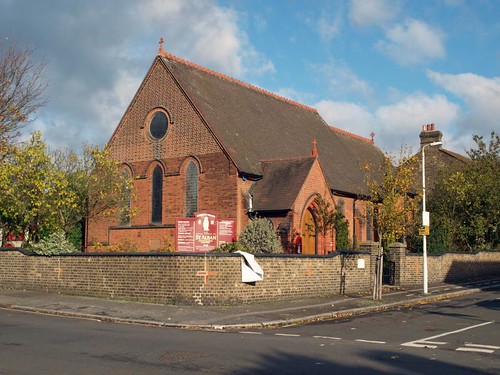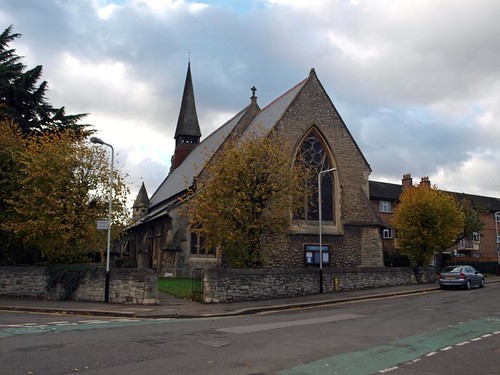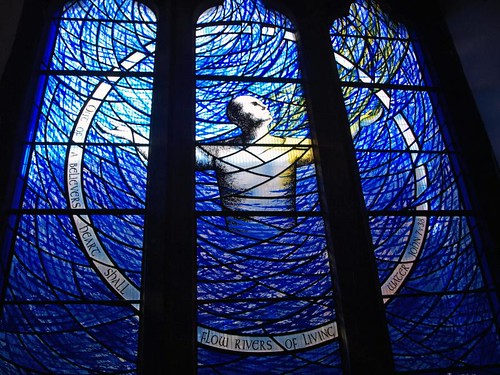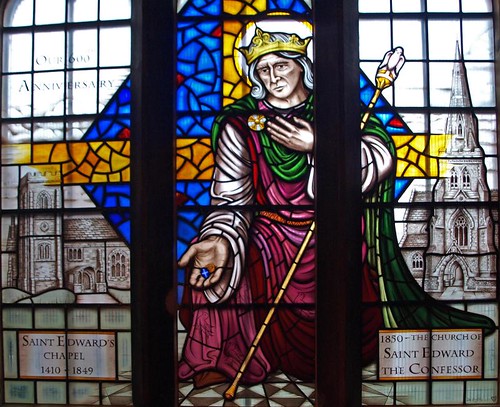A dire Victorian built church, the interest at St Alban lies within - so naturally it's locked no keyholder. I now know that you can pre-organise a visit and having read this article I may invest time on an excursion.
St Edward the Confessor is one of those rare beasts, in my experience, a locked no keyholder RC church. I'm normally pretty confident that I'll find RC churches open but not here. Taking Stock's entry can be found here.
St Andrew, locked no keyholder, and that's probably enough said.
I returned to Romford and found the CoE Edward the Confessor open - a constant stream of people came and went whilst I was there, lighting candles, praying or just dropping in for a chat with the ladies who run the shop at the west end of the church - this should be a shining example to all town churches, an open church attracts visitors and reduces the risk of vandalism or theft.
One of the ladies was interested in why I was visiting and we had a lengthy chat about the church and the district. One of her gems was the tale of St Edward being asked for alms from a beggar on his way to his palace. Finding himself cashless he gave the man one of his rings and that's how Have a ring atte Bower acquired its name - neither of us quite believe the tale but we agreed that it had a ring to it (sorry)!
Anyway this is an interesting, though new build interior, (the exterior is dull) with good modern glass amongst run of the mill Victorian windows and I liked the monuments.
ST EDWARD THE CONFESSOR, Market Place. 1849-50 by John Johnson. Big, with tall spire on the S side facing the Market. Fussy enough to impress. - PLATE. Cup and Paten on foot, probably 1623; two Flagons 1653; Salver 1654; large Cup 1661. - MONUMENTS. Sir Anthony Cooke d. 1576, and family. Broad triptych composition with Corinthian columns. Pediment over the centre. Kneelers in all three parts. - Less good Sir George Hervey d. 1605, and wife. Also Corinthian columns and also kneelers. - Ann Carew d. 1605, semi-reclining effigy, head propped up on elbow.
ROMFORD. It has trebled its population since our century began and has wiped out some ancient local history which now seems rather quaint, but which nevertheless reaches back to Saxon and even Roman times.
For many centuries its countryside had a government of its own, under the name of Havering-atte-Bower, an independent patch in the midst of Essex, with a royal palace belonging to a succession of English queens. Romford had the chief group of population in this little royal Liberty, where Queens went for retirement, or for hunting in the great Essex forest. When the forest vanished before the advance of progressive agriculture, the Liberty became a typical rural marketing centre, as Romford still is, though now it is also within the residential fringe of London. This century it has been given Raphael Park, with handsome iron gates.
If we would seek visible reminders of Romford’s history we must come to the 19th century church of Edward the Confessor, whose 162-foot spire is a landmark all around. It stands boldly in the market place, close to the meeting of the town’s four chief roads. The new church has a great monument from the old one showing Sir Anthony Cooke, whose family was dominant in Romford for nearly 200 years. Sir Anthony kneels in Tudor armour facing his wife in a ruff and cloak. Behind him kneel his two sons, and behind his wife the four daughters who are believed to have composed his long Latin epitaph and to have been the cleverest women of their day. They certainly belonged to a remarkable family.
Sir Anthony was the great-grandson of Sir Thomas, a wealthy Lord Mayor of London who built himself a great house in Gidea Park, near Romford, but made the mistake of backing the losing side in the Wars of the Roses and barely escaped the scaffold. Still, he died rich and in Tudor days his descendants flourished, so much so that Sir Anthony rebuilt Gidea Hall, and as Steward of the Liberty of Havering-atte-Bower entertained Queen Elizabeth there.
Sir Anthony Cooke was a student, in love with country life, and a believer in education as the most broadening influence. He acted as tutor to his four sons and five daughters, and their accomplishments were so much admired that he was chosen tutor to the young King Edward the Sixth, who knighted him at his coronation.
The four daughters on the monument all married well. Mildred married the great Lord Burghley, Elizabeth’s trusted adviser; Ann became the mother of Francis Bacon; Elizabeth’s husband was Lord Russell of the famous Bedford family; Katherine married Sir Henry Killigrew, one of the busiest of Elizabeth’s ambassadors. Gidea Hall has gone and the family is extinct, but the alabaster group passed on from the old church to the new church preserves an enduring household.
Another favourite of Queen Elizabeth is on his monument in the church porch. He is Sir George Hervey, with his wife, five sons, and six daughters. He was the Lieutenant of the Tower. On the opposite wall is Anne Carew’s monument showing her leaning on her elbow and looking far from attractive.
By the church is an interesting 15th century building originally a home for a chantry priest. Then it became the Cock and Bell inn, now it is once more a Church House. Timbered and plastered, it has old beams and 17th century panelling. When we called the cock could still be, seen, on the glass of the door, seated on the bell.
Another link with Romford’s past is a picturesque group of 19th century almshouses round a garden in North Street, close to the River Rom winding its way southward through the town to become the Beam River and finally reach the Thames. Their history goes back to 1482 when Roger Reede’s will bequeathed his newly-built house of Hoocrofts “to be a dwelling place for five poor men, not blasphemers of the name of almighty God, nor common beggars, but such as have been of good governance and fallen into poverty; the saddest and wisest to be the ruler.”
In the manor house of Romford (now vanished) was born in 1592 a poet who for a time was perhaps the most popular English poet in a serious vein. No one is now captivated by reading Francis Quarles, and few have even a nodding acquaintance with him, but he was once a prevailing fashion. Horace Walpole complained that “Milton was forced to wait till the world had done admiring Quarles.” The poet’s family had associations with the Stuart court, and Francis was an ardent pamphleteer defender of Charles; at the same time he was a Puritan in spirit. His style has annoying contradictory qualities. He followed the fashion of elaborate “conceits,” yet no one could write more smoothly and plainly, as we see in this, one of his few famous verses:
My soul, sit thou a patient looker-on,
Judge not the play before the play is done.
Her plot hath many changes; every day
Speaks a new scene: the last act crowns the play.
He had wit and vivacity, but varied it with appalling dolefulness. His obvious piety impressed the serious, but he entangled himself in the literary tricks of his day, and has now been almost wholly excluded even from the most copious anthologies.
For many centuries its countryside had a government of its own, under the name of Havering-atte-Bower, an independent patch in the midst of Essex, with a royal palace belonging to a succession of English queens. Romford had the chief group of population in this little royal Liberty, where Queens went for retirement, or for hunting in the great Essex forest. When the forest vanished before the advance of progressive agriculture, the Liberty became a typical rural marketing centre, as Romford still is, though now it is also within the residential fringe of London. This century it has been given Raphael Park, with handsome iron gates.
If we would seek visible reminders of Romford’s history we must come to the 19th century church of Edward the Confessor, whose 162-foot spire is a landmark all around. It stands boldly in the market place, close to the meeting of the town’s four chief roads. The new church has a great monument from the old one showing Sir Anthony Cooke, whose family was dominant in Romford for nearly 200 years. Sir Anthony kneels in Tudor armour facing his wife in a ruff and cloak. Behind him kneel his two sons, and behind his wife the four daughters who are believed to have composed his long Latin epitaph and to have been the cleverest women of their day. They certainly belonged to a remarkable family.
Sir Anthony was the great-grandson of Sir Thomas, a wealthy Lord Mayor of London who built himself a great house in Gidea Park, near Romford, but made the mistake of backing the losing side in the Wars of the Roses and barely escaped the scaffold. Still, he died rich and in Tudor days his descendants flourished, so much so that Sir Anthony rebuilt Gidea Hall, and as Steward of the Liberty of Havering-atte-Bower entertained Queen Elizabeth there.
Sir Anthony Cooke was a student, in love with country life, and a believer in education as the most broadening influence. He acted as tutor to his four sons and five daughters, and their accomplishments were so much admired that he was chosen tutor to the young King Edward the Sixth, who knighted him at his coronation.
The four daughters on the monument all married well. Mildred married the great Lord Burghley, Elizabeth’s trusted adviser; Ann became the mother of Francis Bacon; Elizabeth’s husband was Lord Russell of the famous Bedford family; Katherine married Sir Henry Killigrew, one of the busiest of Elizabeth’s ambassadors. Gidea Hall has gone and the family is extinct, but the alabaster group passed on from the old church to the new church preserves an enduring household.
Another favourite of Queen Elizabeth is on his monument in the church porch. He is Sir George Hervey, with his wife, five sons, and six daughters. He was the Lieutenant of the Tower. On the opposite wall is Anne Carew’s monument showing her leaning on her elbow and looking far from attractive.
By the church is an interesting 15th century building originally a home for a chantry priest. Then it became the Cock and Bell inn, now it is once more a Church House. Timbered and plastered, it has old beams and 17th century panelling. When we called the cock could still be, seen, on the glass of the door, seated on the bell.
Another link with Romford’s past is a picturesque group of 19th century almshouses round a garden in North Street, close to the River Rom winding its way southward through the town to become the Beam River and finally reach the Thames. Their history goes back to 1482 when Roger Reede’s will bequeathed his newly-built house of Hoocrofts “to be a dwelling place for five poor men, not blasphemers of the name of almighty God, nor common beggars, but such as have been of good governance and fallen into poverty; the saddest and wisest to be the ruler.”
In the manor house of Romford (now vanished) was born in 1592 a poet who for a time was perhaps the most popular English poet in a serious vein. No one is now captivated by reading Francis Quarles, and few have even a nodding acquaintance with him, but he was once a prevailing fashion. Horace Walpole complained that “Milton was forced to wait till the world had done admiring Quarles.” The poet’s family had associations with the Stuart court, and Francis was an ardent pamphleteer defender of Charles; at the same time he was a Puritan in spirit. His style has annoying contradictory qualities. He followed the fashion of elaborate “conceits,” yet no one could write more smoothly and plainly, as we see in this, one of his few famous verses:
My soul, sit thou a patient looker-on,
Judge not the play before the play is done.
Her plot hath many changes; every day
Speaks a new scene: the last act crowns the play.
He had wit and vivacity, but varied it with appalling dolefulness. His obvious piety impressed the serious, but he entangled himself in the literary tricks of his day, and has now been almost wholly excluded even from the most copious anthologies.





No comments:
Post a Comment